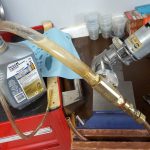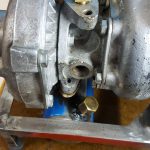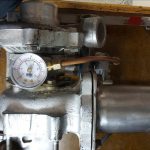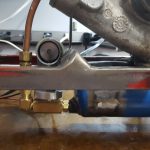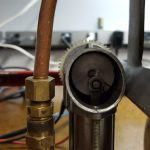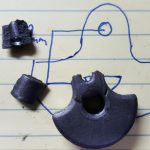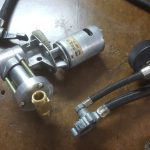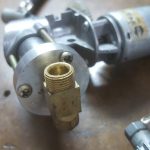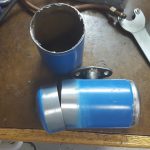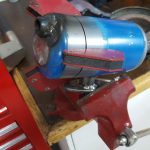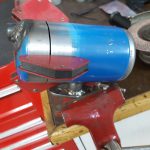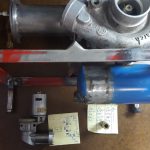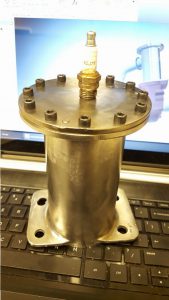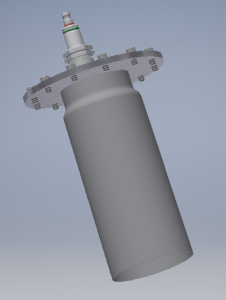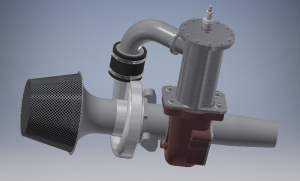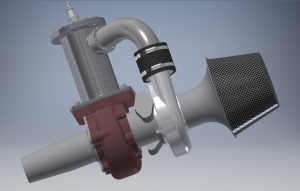Jet Engine Oil System – Test Run
Tonight I tested the oil pump – it worked so well that the pressure blew off one of the plastic tubes I was using for testing and sneezed oil over everything. After I cleaned up the mess I connected it into the system and did another test run. The extra resistance of the oil passing through the turbo bearings caused the pump to stall out on the first attempt. The pump was originally designed to move air, so it’s not surprising that oil was too much of a load. To remedy this I made a new crankshaft for the pump on the lathe with as short of a ‘throw’ for the piston as possible. With the shorter throw, the pump is moving less oil per rev which reduces the load and prevented the motor stall. After this change it successfully ran continuously and held an average pressure in the system of about 75PSI, right about where it needs to be. To keep things simple I don’t have a bypass or pressure regulator in the system; because of this the pressure gauge flutters with each pump stroke but this doesn’t hurt functionality.
The motor draws about 5A, at 12V this is ‘only’ 60Watts and is about the same or even a bit less than when it was an inflator pump. Since it will now be running for longer time periods though I need to keep an eye on the motor temperature. I also need to protect the plastic gear from the (eventual) heat of the combustor above. To address both of these problems I’ll likely make a heat shield for this area as well as add a cooling fan.
Jet Engine Oil System
This weekend I resumed work on the jet engine project. When I last left off I had just completed the frame and mounted the turbocharger/combustor. I had also fabricated an oil tank out of an old propane tank and mounted it under the turbo, but had hit a bit of a wall with what to do for an oil pump. There are electric oil pumps available, but basically all of them would be overkill for this application. Also, since this is a hobby I’d much rather put in the time to make something custom vs paying for parts. Turbocharger jet engines have been done by many others, my approach with this is to see how compact and well packaged I can make one – that doesn’t happen by bolting together a bunch of off-the-shelf parts.
I had considered using the bus’s old oil pump, but this created more problems than it solved (connection of inlet/output pipes would be a challenge as would driving it and selecting a motor). Today after a taking a fresh look at it I realized that an old 12V tire inflator pump that I had could be adapted to work. The plastic casing had broken, but the ‘guts’ were all metal and should hold up to oil pump duty. The only problem was that the cylinder head of the pump had no way of connecting an inlet pipe – being designed for air, it just drew in air from a small hole. To fix this, I made a new cylinder head on the lathe with one large hole in the center. A tee fitting screws into the head and I’ll put a check valve on each side. This larger single-hole head should also help compensate for the increased load of pumping oil, much thicker than air. Once I start running oil through it I may have to make some tweaks to avoid overload (lower voltage, thin oil, etc) but this at least gives a path forward for experimentation.
I also shortened the oil tank to make more room underneath for other support systems and made a threaded port on the lathe to weld into the tank to connect the oil pump. The welds aren’t the greatest looking, but are leak-free and that’s what matters – they should clean up OK after some grinding. For now the whole project is in fabrication mode, but once everything is in place and working I’ll go back and do body/paint work on all the parts to make it look nice too.
Jet Engine Update
The jet engine combustor is now mostly complete, all that’s left for it is to #1 drill/tap for the spark plug and fuel injector(s) and #2 add an intake duct for compressor air. I’ve also mostly completed the 3D model – there aren’t many straight lines or surfaces on it, remembering all the 3D modeling tricks to make this was a lot of fun. I even went a bit overkill with the model – I may not actually build a bell mouth intake, screen, and/or jet tube.
The biggest looming challenge is deciding on a hole pattern for the flame tube. It’s critical that the flame tube holes are in the right places to correctly ‘hold’ the flame through various engine speeds, particularly while starting. If there are too many holes the air will mix too readily and the flame will be blown out, not enough holes and the engine will starve for air and not achieve self-sustaining operation. This is the biggest area for experimentation on the system and it’s why I made the flame tube easily removable from the combustor, modifications may need to be made.
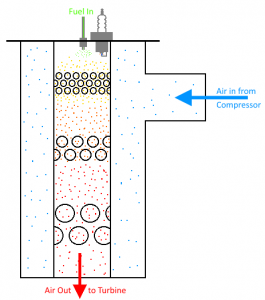
Beyond that, everything else is just basic design, fabrication, plumbing, and wiring:
- Finish 3D module including stand w/ various support systems
- Oil system (Oil tank, oil pump, electric motor)
- Fuel system (This will be propane at first for simplicity and safety, but provisions may be made for future use on Diesel/Kero/JetA)
- Starting system (Air jet strategically aimed at compressor wheel)
- Ignition system (old ignition coil excited by a power transistor pulsed by the control system)
- Electrical design, construction, and programming for instrumentation & control system (tachometer, temperature sensors, etc)
Gas Turbine!
Before anyone gets excited, this is in reference to BUILDING a gas turbine (jet) engine rather than flying one, but it should be almost as much fun…
I’ve had a gas turbine (jet) engine on my ‘some day’ projects list for a long time. While cleaning the shop the other day I realized that I now have basically everything needed to complete this: a spare turbocharger, old oil pump, numerous microcontroller demo boards, various switches & sensors, scrap metal, and an assortment of plumbing fittings. All that’s needed to make it happen is to design and build it – a fun ‘free’ project.
I started on the combustor tonight. Fabrication should be generally easy compared to the CNC machine build, however without a lathe or mill there are some parts that I will have to fabricate creatively. I have jumped the gun a bit in not designing digitally first. In general the design will consist of wild guesses based on other similar projects online; so I haven’t lost out on anything by not having a digital model first, but I will create one as I go to make future changes easier to understand.


